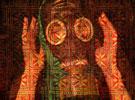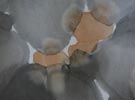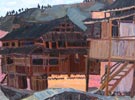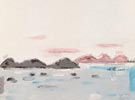On the Art of Qu Qianmei
Deng Pingxiang
﹒The Inquiry of Pure Land
There was a concise but profound essay in Qu Qianmei’s personal pictorial - The Inner Pilgrimage, in which she inquired, “Where is pure land? Where is pure land?” Thus with this inquiry into the spirituality of pure land in mind, she went to Tibet.
After the return from Tibet, she said: “I can bear it no longer so I shall have an outlet, I have found the direction.”
After reading these words, I feel the writer does not only possess the true chastity of art, but also a thorough comprehension of art. It can be said that Qu Qianmei has solved the problem of the matter of art’s spirit and soul, thus the spiritual quality of the law of art is no longer a problem after commencing art expression I can also state it like this: the painter has revealed the spiritual approach of artistic expression.
In today’s world, Tibet is probably recognized as being one of the only pure lands left to humans. Following on from original sin, human’s desires and self-interests have gone through many evolutionary processes to create a social formation and humans have often betrayed nature, estranged god and been indifferent to their fellow human beings. Saints have long warned that “Men are not what they were in times past and the general moves are getting worse and worse.”
While Tibet is the only surviving holy place for people to revere the spiritual being while attempting to risk their lives to communicate with god.
The representative of “cyma”, the philosopher Marcuse, in confronting the people of today in a world prevailing with capitalism, science and power politics, once put forward a famous proposition, that believes that art was more faithful to the ideal of the confirming culture than religion or philosophy…the value of art lies in aesthetic factors foreboding the realization of individual consummation and freedom in the conflicts between art and society.
It must be pointed out that in China today, the reduction of spiritual beliefs and emotional desertification are similar throughout society all over the world. This is the grim reality that the real art in modern and contemporary times (including Qu Qianmei) must face. With this in mind, the value revealed by spiritual seems so precious. Unfortunately, it is so common a phenomenon to utilize art in modern and contemporary art fields that it becomes a question if it is possible to return to the essence and natural quality of art.
From the inquiry of pure land to the expression and exploration of art, Qu Qianmei created inspirational works, which made her life’s purpose coincide with her artistic nature. At this point, I’d like to share with you a famous saying from Hegel: ‘the nobility of spirit is the greatest nobility’.
﹒Humanities and Women
There’s no definitive meaning of femininity and feminine art in the initial reading of Qu Qianmei’s art. It leads people to appreciate and view it only as you would general art. This reminds me of a question, or a misunderstanding of feminine artistic creation and feminine criticism, that is: whether humanities are greater than femininity, or the opposite? The author demonstrates no negative highlights on the feminine art features, but one needs to know, whether they are highlighted or not. It seems absurd as to separate femininity from humanity, or even use femininity to contradict humanity. For this question I fully appreciate the concept of “the holy grail and sword” proposed by Richard Ann Eisler (US), a famous female thinker, from which she also cited “the dynamics theory of human culture’s bi-stability”. I believe China’s feminine art movement and feminine art criticism should get in touch with or learn this masterpiece by Richard Ann, which is likely to change the thinking around feminine art and feminine art criticism.
In fact, as an individual, Qu Qianmei is female with femininity. Her personality reveals that she is calm and willing to listen attentively, which form a large contrast to the spectacularly large images in her art works. If we superficially compare this with “the style is the man”, we may be puzzled, yet this situation is also considered normal. I think the difference originates mainly from her cultural upbringing and spiritual temperament. Naturally, she reminds me of the origin of “quiet girls are very beautiful”. Meng Jiao said in “On Quiet Girls” that “coquettish girls are jealous of beauty, while quiet girls are detached and unfettered”. There are too many coquettish girls represented in life, while quiet girls are few and far between, so that’s why the latter is “very beautiful”.
﹒Ontology of abstract art and artistic personality
As Qu Qianmei has lived in France for many years, her abstract art has no “image” feature as with “local” abstract artists at the start of their artistic career.
The art of “free-sketch literati paintings” represents the highest level of Chinese painting which naturally reveals the intention of abstract art is in its’ pen and ink structure, and often the higher the thoughts and achievements that the painter has, the more obvious the abstract factors are. Is this the prelude of abstract art? Yet China’s free-sketch literati paintings did not ultimately develop into abstract art, so the reason that is has developed is worth studying. I believe that it is largely determined by Chinese ideology. In China’s philosophy, pure symbol thinking and logical ideas have not been developed, causing “four great inventions” to linger within the scope of experience, without rising to the state of deduction using physics or scientific analysis.
As far as an academic category is concerned, Qu Qianmei’s abstract art belongs to structuralism, rather than image abstraction (semi abstract). Maybe some people would consider, this is western-style nationalism and that ideology may be forthcoming at a later stage. Why is art the art of “certain country” or “certain nation”? Can art like the “human art” and “art for human” of Solzhenitsyn be more open? Is inclusion not greater?
On the whole, Qu Qianmei’s abstract art is heavy and grand as well as deep and remote, melancholy but robust, and it is rich and changing in abstract vocabulary. For the use of language, it seems to be under the guidance of God and her spirit, she paints what interests her, she begins where she should begin and stops where she should stop, as if in a world of total submersion.
As a female artist, the dominant factor in Qu Qianmei’s art is masculinity, but always with a feminine grounding. Essentially, the tragic air in some of her works is rarely seen by most women. This is not only the externalization of her destiny, but also the profound realization of the tragic fate of human beings. There are observations of uneven hardship and higher sympathy, which constitute her inner feelings of universal value - according to the thought of the German thinker Scheler, they belong to the highest value category.
To conclude, I’d like to give some advice to the painter that she may occasionally let loose her grip and in some places, so as to make her works appear “out of control” and “irrational” consequently in a way, the works reveal amazing charm, and the her art is given a fuller perceptual content.




